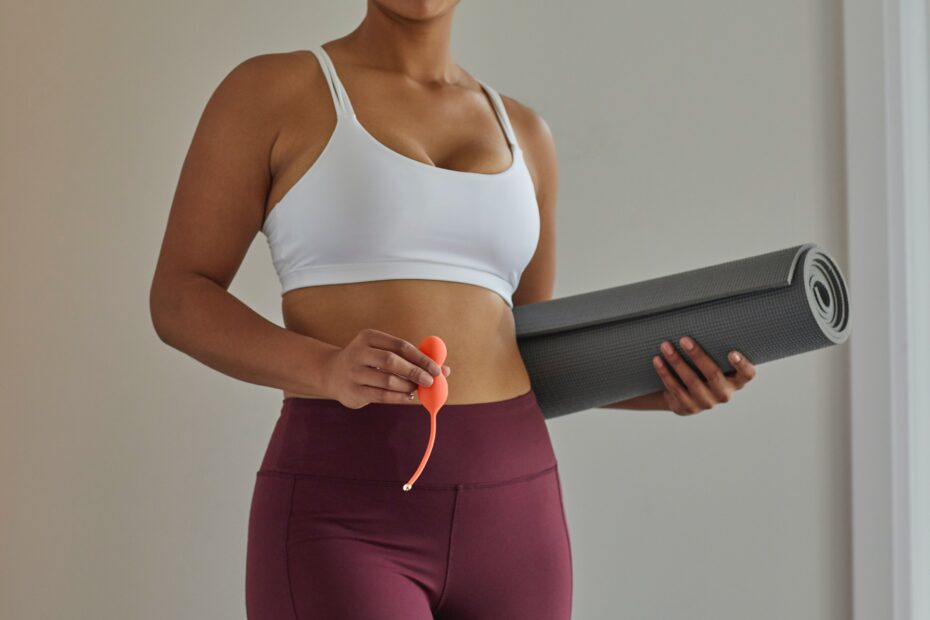Yoga can improve both your flexibility and strength. The challenges of alignment, endurance, balance, and pain that you may discover in your yoga practice often stem from an underdeveloped and imbalanced core; exercises which tone and elongate the abdominals can alleviate back pain, improve posture, breathing, balance, and your ability to maintain a pose for an extended time period.
A daily routine of some or all of the asanas below will target the abdominal region, transform your overall practice, and enhance your enjoyment of yoga.
Elongate and Rejuvenate
To develop a healthy core and abdominal area, it is just as important to stretch these muscles as it is to strengthen them. Stretching also circulates and renews blood and other fluids in these tissues.
- Cobra (Bhujangasana)
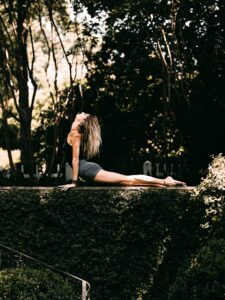
Lie face down on your mat. With feet and legs together, place your hands beneath or beside your shoulders. Straighten your arms and lift the chest as you inhale. Do not let the head fall back in this posture, compressing the cervical vertebrae. Rather, keep the back of the neck long by gazing up “through” your forehead and rolling the shoulder blades together and down the back. Sink the pelvic bones into the earth as you simultaneously lift the heart up and out, elongating and opening the abdominal area and stretching the torso muscles along the front and sides of the body. You may also lift the knees off the ground (coming into upward facing dog, or Urdhvamukhasvan Asana). In this position, the lower abdominals in particular should be engaged and the tailbone should be “tucked” in to protect the low back.
- Standing Crescent Moon (Ardha Chandrasana I)
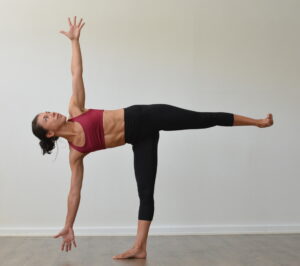
Stand in Mountain Pose (Tadasana) with feet together or hip width apart. Inhale your arms overhead and clasp the hands together, interlacing the last three fingers and thumbs while pointing your index fingers skyward. Exhale to one side, looking up slightly into your elbow and tucking the chin to keep the back of the neck long. Turn the hips slightly in the direction you are facing, keeping both sides of the body long and the chest open. Engage the low abdominals and “tuck” your tailbone to protect the low back. This posture will lengthen the obliques and the muscles along the rib cage and underarms.
Engage and Strengthen
- Plank Pose (Chaturanga Dandasana)
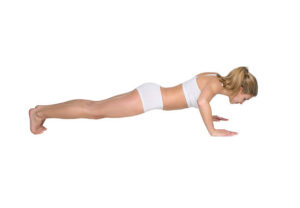
From the Downward Dog posture or from lying face down on the floor, come into a high push up position, arms straight, hands directly beneath the shoulders, and spine aligned from tailbone to head. Bend the elbows, being careful to keep them pressed firmly against the sides of the body. Lower yourself to just an inch or so above the ground. To maintain a straight spine, the abdominals must be strongly engaged. Breathe vigorously through the nose to increase heat and energy flow in the abdominal region.
- Dolphin (Makarasana) Pushups
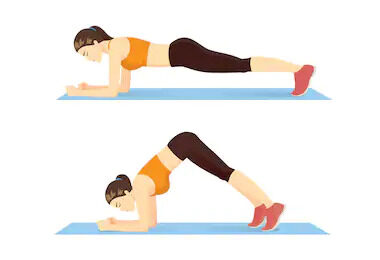
Begin sitting on your heels. Lean forward and place your forearms on the floor with your elbows about a foot apart. Clasp your hands, forming a tripod between your elbows and hands. Curl your toes under and lift the sit bones in the air until the legs are straight. As you exhale, bring your head between your elbows; as you inhale, bring your sternum (chest plate) above your hands. This movement requires the engagement of the entire abdominal area, toning and strengthening the muscles without the neck and back strain of conventional sit ups. This movement also exercises the muscles of the upper arms and back, stretches the back of the legs, and prepares you for headstand.
- Headstand (Shirshasana)
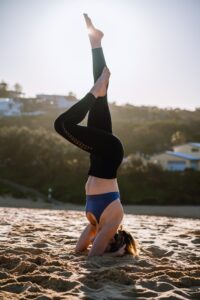
Because your core, or torso, must be engaged to maintain balance and spinal alignment, any asana involving these two principles will strengthen the abdominal region when done correctly. Assume the same arm position as in dolphin pose, but place your head on the ground with the back of the skull resting against your hands, which should be loosely clasped. Headstand may first be attempted against a wall, kicking the legs up one at a time. Let the heels rest against the wall, then use the abdominals to straighten the body and balance the legs away from the wall.
The key to raising the legs up together and straight is, of course, engaging the abdominal muscles. With your toes curled and legs straight, walk the feet towards the head. Let the buttocks tilt back as your legs rise up off the ground. As the feet come above the torso, the buttocks will come back towards the midline of the body to maintain balance. The weight of the lower body is stabilized and supported by the torso. Once balance in the neutral position is achieved with ease, try twisting from the hips from one side to the other to further challenge the abdominal area. This asana also tones the internal organs, improves circulation, and calms and focuses the mind.
